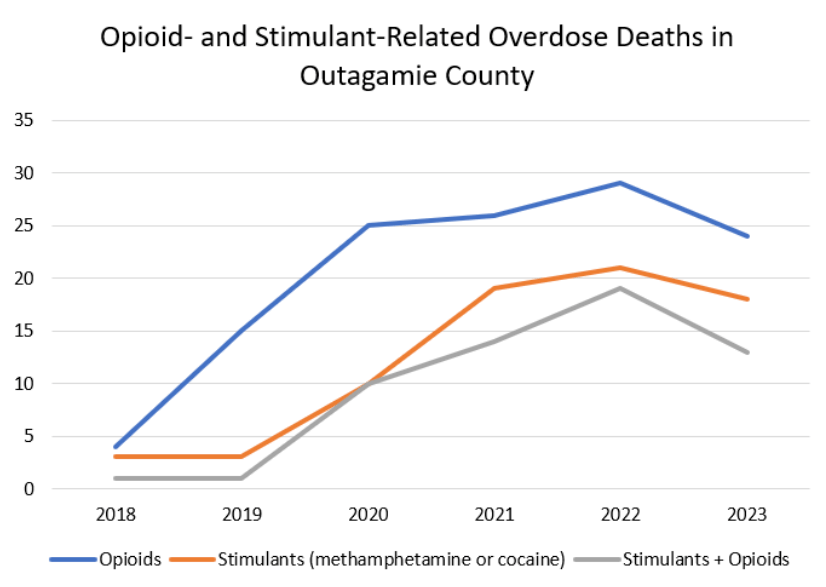By one measure, Outagamie and Brown at top of list
Meth is injected, smoked, snorted or ingested in just about every corner of Wisconsin.

But by at least one measure the insidious problem is worse in two adjacent counties — Brown and Outagamie — than anywhere else.
In 2023, the drug most often identified in samples sent by law enforcement to the State Crime Lab was meth, which accounted for 1,378 of the 4,805 samples tested — more than cocaine or heroin or fentanyl or even THC, the active ingredient in cannabis.
Outagamie accounted for 124 of the meth samples, according to new data acquired from the Department of Justice. Neighboring Brown County accounted for 120. Barron was third with 79 and Milwaukee County, which is twice as big as Brown and Outagamie combined, had 74.
We can’t be absolutely certain meth users are more prevalent in those counties. Users, of course, are often not identified unless they are caught or go crazy like the naked guy with the dog leash around his waist we wrote about in Juneau County not long ago. Plus, cops and prosecutors don’t send all the drugs they recover to the lab.
That said, Brown and Outagamie either have much more aggressive law enforcement or a lot more usage than most other places.
It’s unclear exactly why.
Justin Stingle, president of Black Creek, speculated it might have something to do with drug dealers heading north through the county.
He has lived in Black Creek for 15 years and makes it sound pretty idyllic.
“Everybody knows who you are, who your kids are,” he said. “It’s a relatively safe community. Years ago, we had a bank robbery but there’s not a lot that goes on here.”
I called him because a story in one of the Gannett papers last fall mentioned a criminal complaint that stated a confidential informant had purchased both fentanyl and methamphetamine in the small village of 1,360 people in Outagamie County. Stingle is stumped as to why anyone anywhere would use it but he knows people do.
“My best friend is a recovering meth addict,” he said. “Been clean for a few years now.”
“I grew up in the country. I did not partake in any of those things. It’s a struggle understanding why people would do it. My friend, he said the first time was the best ever; then every time after that you’re chasing it.”
“Once you do it, you’re going to continue to do it.”
Methamphetamine-related overdose deaths are up in the county in recent years and peaked in 2022, although opioid overdoses are still more prevalent and both have come down since then.
In Brown County, the County Drug Task Force made 659 drug-related arrests last year. A quarter to a third are meth-related, according to Lt. Matt Ronk, a Brown County sheriff’s deputy who is the director of the task force. Fentanyl remains the number one drug of abuse, he said, and cocaine is making a roaring comeback.
Meth seizures were way up in 2024, from 3,500 grams in 2022 to 8,790 grams in 2023 to over 21,000 grams in 2024 — although, he said, the increase was skewed by a monster seizure in 2024. Ten years ago, in 2014, only 256 grams of meth were seized.
“So the numbers have trended upward (over the last 10 years or so). But compared to fentanyl seizures, it’s apples and oranges. I’m not trying to minimize the threat to the community. At one time, around 2016 and 2017, meth was the biggest threat. Then heroin started creeping up, then synthetic opioids took over. Now our communities are swimming in fentanyl.”
Most meth and fentanyl is made in Mexico and comes across the southwest border. Most meth comes up from Chicago and Milwaukee and a fair amount comes from the Twin Cities.
“I would love to say just don’t do it,” said Stingle. “That has been my solution personally. I don’t know what causes people to do it.”
Ken Wysocky is a Milwaukee-area freelance journalist and editor with more than 40 years of journalism experience. Mike Nichols is the President of the Badger Institute.
Any use or reproduction of Badger Institute articles or photographs requires prior written permission. To request permission to post articles on a website or print copies for distribution, contact Badger Institute President Mike Nichols at mike@badgerinstitute.org or 262-389-8239.
Submit a comment
"*" indicates required fields





